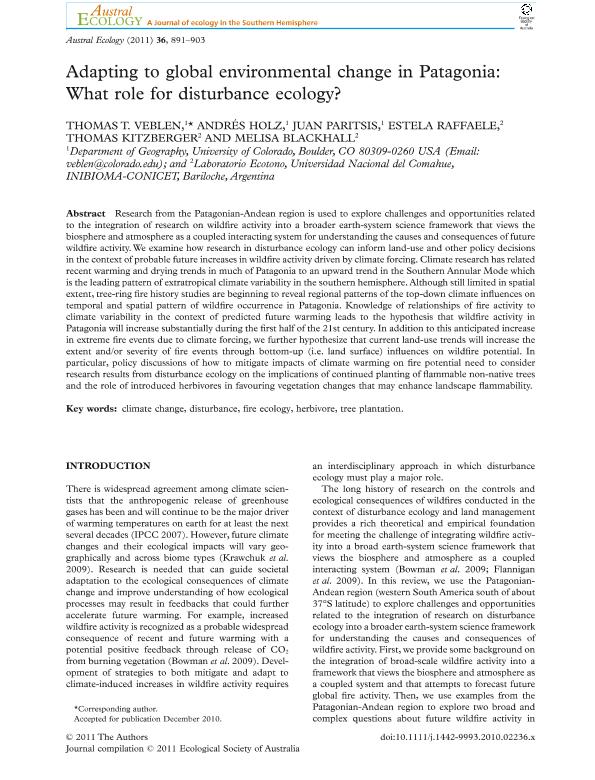Mostrar el registro sencillo del ítem
dc.contributor.author
Veblen, Thomas

dc.contributor.author
Holz, Andrés

dc.contributor.author
Paritsis, Juan

dc.contributor.author
Raffaele, Estela

dc.contributor.author
Kitzberger, Thomas

dc.contributor.author
Blackhall, Melisa

dc.date.available
2019-05-20T18:20:09Z
dc.date.issued
2011-12-18
dc.identifier.citation
Veblen, Thomas; Holz, Andrés; Paritsis, Juan; Raffaele, Estela; Kitzberger, Thomas; et al.; Adapting to global environmental change in Patagonia: What role for disturbance ecology?; Wiley Blackwell Publishing, Inc; Austral Ecology; 36; 8; 18-12-2011; 891-903
dc.identifier.issn
1442-9985
dc.identifier.uri
http://hdl.handle.net/11336/76727
dc.description.abstract
Research from the Patagonian-Andean region is used to explore challenges and opportunities related to the integration of research on wildfire activity into a broader earth-system science framework that views the biosphere and atmosphere as a coupled interacting system for understanding the causes and consequences of future wildfire activity. We examine how research in disturbance ecology can inform land-use and other policy decisions in the context of probable future increases in wildfire activity driven by climate forcing. Climate research has related recent warming and drying trends in much of Patagonia to an upward trend in the Southern Annular Mode which is the leading pattern of extratropical climate variability in the southern hemisphere. Although still limited in spatial extent, tree-ring fire history studies are beginning to reveal regional patterns of the top-down climate influences on temporal and spatial pattern of wildfire occurrence in Patagonia. Knowledge of relationships of fire activity to climate variability in the context of predicted future warming leads to the hypothesis that wildfire activity in Patagonia will increase substantially during the first half of the 21st century. In addition to this anticipated increase in extreme fire events due to climate forcing, we further hypothesize that current land-use trends will increase the extent and/or severity of fire events through bottom-up (i.e. land surface) influences on wildfire potential. In particular, policy discussions of how to mitigate impacts of climate warming on fire potential need to consider research results from disturbance ecology on the implications of continued planting of flammable non-native trees and the role of introduced herbivores in favouring vegetation changes that may enhance landscape flammability.
dc.format
application/pdf
dc.language.iso
eng
dc.publisher
Wiley Blackwell Publishing, Inc

dc.rights
info:eu-repo/semantics/openAccess
dc.rights.uri
https://creativecommons.org/licenses/by-nc-sa/2.5/ar/
dc.subject
Climate Change
dc.subject
Disturbance
dc.subject
Fire Ecology
dc.subject
Herbivore
dc.subject
Tree Plantation
dc.subject.classification
Otras Ciencias Biológicas

dc.subject.classification
Ciencias Biológicas

dc.subject.classification
CIENCIAS NATURALES Y EXACTAS

dc.title
Adapting to global environmental change in Patagonia: What role for disturbance ecology?
dc.type
info:eu-repo/semantics/article
dc.type
info:ar-repo/semantics/artículo
dc.type
info:eu-repo/semantics/publishedVersion
dc.date.updated
2019-04-23T15:05:28Z
dc.journal.volume
36
dc.journal.number
8
dc.journal.pagination
891-903
dc.journal.pais
Reino Unido

dc.journal.ciudad
Londres
dc.description.fil
Fil: Veblen, Thomas. University of Colorado; Estados Unidos
dc.description.fil
Fil: Holz, Andrés. University of Colorado; Estados Unidos
dc.description.fil
Fil: Paritsis, Juan. Consejo Nacional de Investigaciones Científicas y Técnicas. Centro Científico Tecnológico Conicet - Patagonia Norte. Instituto de Investigaciones en Biodiversidad y Medioambiente. Universidad Nacional del Comahue. Centro Regional Universidad Bariloche. Instituto de Investigaciones en Biodiversidad y Medioambiente; Argentina. University of Colorado; Estados Unidos
dc.description.fil
Fil: Raffaele, Estela. Consejo Nacional de Investigaciones Científicas y Técnicas. Centro Científico Tecnológico Conicet - Patagonia Norte. Instituto de Investigaciones en Biodiversidad y Medioambiente. Universidad Nacional del Comahue. Centro Regional Universidad Bariloche. Instituto de Investigaciones en Biodiversidad y Medioambiente; Argentina. Universidad Nacional del Comahue. Centro Regional Universitario Bariloche. Laboratorio de Ecotono; Argentina
dc.description.fil
Fil: Kitzberger, Thomas. Consejo Nacional de Investigaciones Científicas y Técnicas. Centro Científico Tecnológico Conicet - Patagonia Norte. Instituto de Investigaciones en Biodiversidad y Medioambiente. Universidad Nacional del Comahue. Centro Regional Universidad Bariloche. Instituto de Investigaciones en Biodiversidad y Medioambiente; Argentina. Universidad Nacional del Comahue. Centro Regional Universitario Bariloche. Laboratorio de Ecotono; Argentina
dc.description.fil
Fil: Blackhall, Melisa. Consejo Nacional de Investigaciones Científicas y Técnicas. Centro Científico Tecnológico Conicet - Patagonia Norte. Instituto de Investigaciones en Biodiversidad y Medioambiente. Universidad Nacional del Comahue. Centro Regional Universidad Bariloche. Instituto de Investigaciones en Biodiversidad y Medioambiente; Argentina. Universidad Nacional del Comahue. Centro Regional Universitario Bariloche. Laboratorio de Ecotono; Argentina
dc.journal.title
Austral Ecology

dc.relation.alternativeid
info:eu-repo/semantics/altIdentifier/doi/http://dx.doi.org/10.1111/j.1442-9993.2010.02236.x
dc.relation.alternativeid
info:eu-repo/semantics/altIdentifier/url/https://onlinelibrary.wiley.com/doi/abs/10.1111/j.1442-9993.2010.02236.x
Archivos asociados
